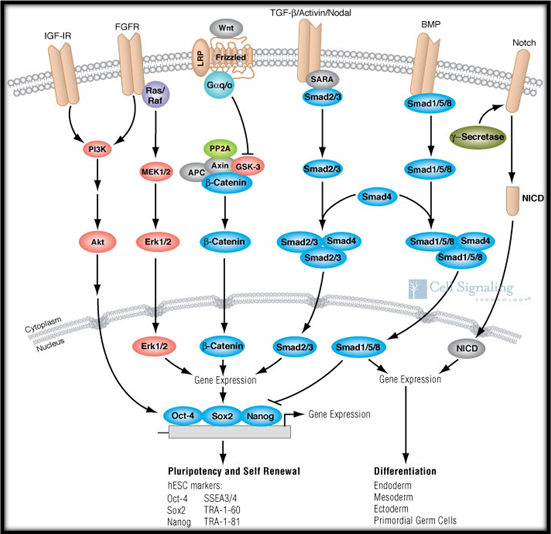MOLECULES INVOLVED IN REGULATION OF STEM CELL DIFFERENTITIATION
Cell adeshive molecule E_cadhedrin which replaces oct 4signalling molecule there by converting normal somatic cell into pluripotent
PROTIENS Involved; leukemia inhibitory factor a cytokine reinforces stem cell regulation. CCL2 A chemokine ligand VIA JAK/STAT3 pathway.
[adsense:336x280:8701650588]
ENZYMES INVOLVED: histone modification enzymes depletion helps in maintain of pluripotency of a cell at the cost of self renewal CARBOHYDRATE INVOLVED; heparin sulfate helps in signaling molecules such as wnt,fgf, bmp cannot induce signaling without heparin sulfate.
Growth factors involved transforming growth factor, fibroblast growth factor
[adsense:468x15:2204050025]
EPIGENETIC CONTROL:
Genes involved; OCT4, SOX2 help in IPSC reprogramming an d maintain pluripotency. KLF4and myc help in gene silencing .Methylation of polycombrepressor complex stops differentiation. acytelation of H3lysine by trithorax protein help in differentiation.
SIGNALLING PATHWAYS;
ESCs (hESCs), the predominant signaling pathways involved in pluripotency and self renewal are TGF-β, which signals through Smad2/3/4, and FGFR, which activates the MAPK and Akt pathways. The Wnt pathway also promotes pluripotency through activation of β-catenin. Signaling through these pathways results in the expression and activation of three key transcription factors: Oct-4, Sox2, and Nanog. These transcription factors activate gene expression of ESC specific genes, regulate their own expression, and also serve as hESCs markers. Other markers used to identify hESCs are the cell surface glycolipid SSEA3/4, and glycoproteins TRA-1-60 and TRA-1-81.

Article by,
SOWMYA CHIRRAVURI
M.Sc BIOCHEMISTRY









